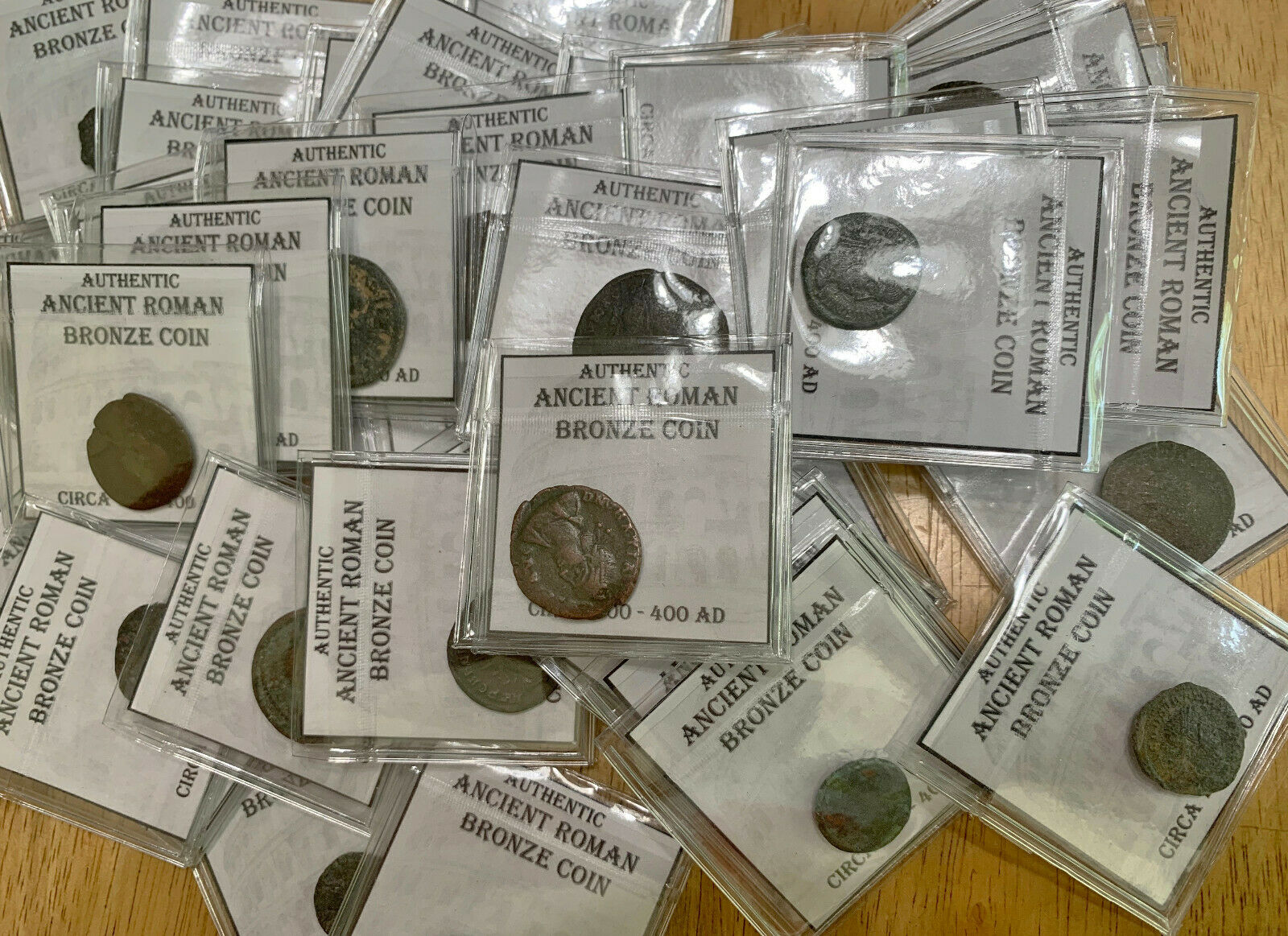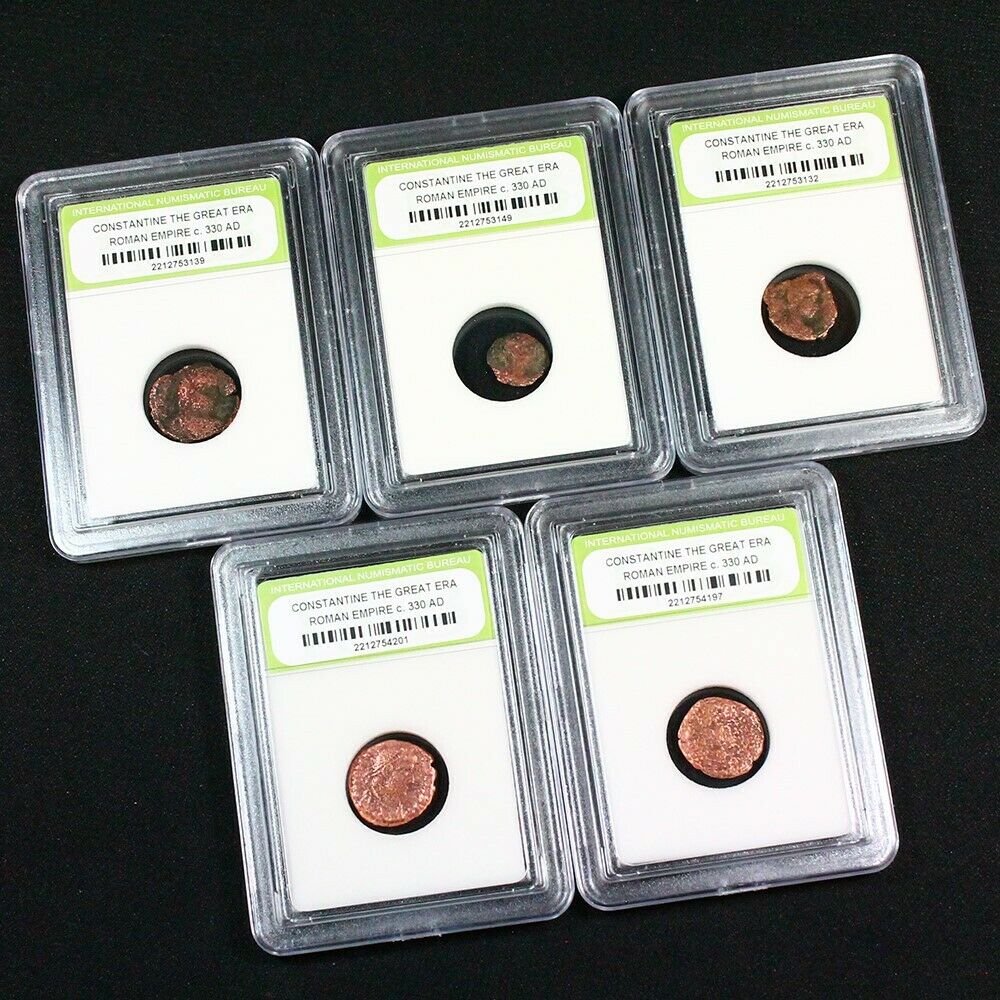-40%
Ancient Roman Empire Coin Commemorative CITY OF CONSTANTINOPLE Winged Victory
$ 17.45
- Description
- Size Guide
Description


ROMAN EMPIRE
Ancient Coin
AE3
Of
Commemorative Issue
Constantinople
Obv: CONSTANTINOPOLIS
Helmeted crested bust left in
imperial mantle holding scepter
Rev:
Victory with wings, foot on
vessel's prow, holding scepter
and leaning on shield
17.00 mm
PRIVATE
ANCIENT COINS COLLECTION
SOUTH FLORIDA ESTATE SALE
( Please, check out other ancient coins we have available for sale. We are offering 1000+ ancient coins collection)
ALL COINS ARE GENUINE
LIFETIME GUARANTEE
AND PROFESSIONALLY ATTRIBUTED
The attribution label is printed on archival museum quality paper
An interesting commemorative coin for the city of Constantinople. Helmeted bust on obverse and winged Victory on reverse. This coin comes with display case, stand and attribution label attached as pictured. A great way to display an ancient coins collection! You are welcome to ask any questions prior buying or bidding. We can ship it anywhere within continental U.S. for a flat rate of 6.90$. It includes shipping, delivery confirmation and packaging material.
Limited Time Offer:
FREE SHIPPING
(only within the continental U.S.)
The residents of HI/AK/U.S. Territories and International bidders/buyers must contact us for the shipping quote before bidding/buying
Constantinopolis
Constantine I had ambitious plans. Having restored the unity of the empire, now overseeing the progress of major governmental reforms and sponsoring the consolidation of the Christian church, Constantine was well aware that Rome had become an unsatisfactory capital for several reasons. Located in central Italy, Rome lay too far from the eastern imperial frontiers, and hence also from the legions and the Imperial courts. Moreover, Rome offered an undesirable playground for disaffected politicians; it also suffered regularly from flooding and from malaria.
It seemed impossible to many that the capital could be moved. Nevertheless, Constantine identified the site of Byzantium as the correct place: a city where an emperor could sit, readily defended, with easy access to the Danube or the Euphrates frontiers, his court supplied from the rich gardens and sophisticated workshops of Roman Asia, his treasuries filled by the wealthiest provinces of the empire.
Constantine laid out the expanded city, dividing it into 14 regions, and ornamenting it with great public works worthy of a great imperial city. Yet initially Constantinople did not have all the dignities of Rome, possessing a proconsul, rather than a prefect of the city. Furthermore, it had no praetors, tribunes, or quaestors. Although Constantinople did have senators, they held the title clarus, not clarissimus, like those of Rome. Constantinople also lacked the panoply of other administrative offices regulating the food supply, police, statues, temples, sewers, aqueducts, or other public works. The new program of building was carried out in great haste: columns, marbles, doors, and tiles were taken wholesale from the temples of the empire and moved to the new city. Similarly, many of the greatest works of Greek and Roman art were soon to be seen in its squares and streets. The emperor stimulated private building by promising householders gifts of land from the imperial estates in Asiana and Pontica, and on May 18, 332 C.E. he announced that, as in Rome, free distributions of food would be made to citizens. At the time the amount is said to have been 80,000 rations a day, doled out from 117 distribution points around the city.
Medieval Constantinople
Constantinople was a Greek Orthodox Christian city, lying in the most Christianized part of the Empire. Justinian (483-565 C.E.) ordered the Pagan temples of Byzantium to be deconstructed, and erected the splendid Church of the Holy Wisdom, Sancta Sophia (also known as Hagia Sophia in Greek), as the centerpiece of his Christian capital. He oversaw also the building of the Church of the Holy Apostles, and that of Hagia Irene.
Constantine laid out anew the square at the middle of old Byzantium, naming it the Augusteum. Sancta Sophia lay on the north side of the Augusteum. The new senate-house (or Curia) was housed in a basilica on the east side. On the south side of the great square was erected the Great Palace of the emperor with its imposing entrance, the Chalke, and its ceremonial suite known as the Palace of Daphne. Located immediately nearby was the vast Hippodrome for chariot races, seating over 80,000 spectators, and the Baths of Zeuxippus (both originally built in the time of Septimius Severus). At the entrance at the western end of the Augusteum was the Milion, a vaulted monument from which distances were measured across the Eastern Empire.
From the Augusteum a great street, the Mese, led, lined with colonnades. As it descended the First Hill of the city and climbed the Second Hill, it passed on the left the Praetorium or law-court. Then it passed through the oval Forum of Constantine where there was a second senate-house, then on and through the Forum of Taurus and then the Forum of Bous, and finally up the Sixth Hill and through to the Golden Gate on the Propontis. The Mese would be seven Roman miles long to the Golden Gate of the Walls of Theodosius.
Constantine erected a high column in the middle of the Forum, on the Second Hill, with a statue of himself at the top, crowned with a halo of seven rays and looking towards the rising sun.
The first known prefect of the City of Constantinople was Honoratus, who took office on December 11, 359 and held it until 361 C.E. Emperor Valens built the Palace of Hebdomon on the shore of the Propontis near the Golden Gate, probably for use when reviewing troops. All the emperors who were elevated at Constantinople, up to Zeno and Basiliscus, were crowned and acclaimed at the Hebdomon. Theodosius I founded the church of John the Baptist to house the skull of the saint, put up a memorial pillar to himself in the Forum of Taurus, and turned the ruined temple of Aphrodite into a coach house for the Praetorian Prefect; Arcadius built a new forum named after himself on the Mese, near the walls of Constantine.
Gradually the importance of the city increased. Following the shock of the Battle of Adrianople in 376 C.E., when the emperor Valens with the flower of the Roman armies was destroyed by the Goths within a few days' march of the city, Constantinople looked to its defenses, and Theodosius II built in 413-414 the 60-foot tall walls which were never to be breached until the coming of gunpowder. Theodosius also founded a university at the Capitolium near the Forum of Taurus, on February 27, 425.
In the fifth century C.E., the Huns, led by Attila, demanded tribute from Constantinople. The city refused to pay, and Attila was about to wage conquest upon the city when a message from Honoria, a sister of Valentinian III, was interpreted by Attila as a marriage proposal, so instead of laying siege to Constantinople, Attila redirected his raiders' assault on the Western Roman Empire, namely in Gaul, Orléans, and Rome.
Just a few years later, when the barbarians overran the Western Empire, its emperors retreated to Ravenna before it collapsed altogether. Thereafter, Constantinople became in truth the largest city of the Empire and of the world. Emperors were no longer peripatetic between various court capitals and palaces. They remained in their palace in the Great City, and sent generals to command their armies. The wealth of the Eastern Mediterranean and Western Asia flowed into Constantinople.
SHIPPING INFO:
- The Shipping Charge is a flat rate and it includes postage, delivery confirmation, insurance up to the value (if specified), shipping box (from 0.99$ to 5.99$ depends on a size) and packaging material (bubble wrap, wrapping paper, foam if needed)
- We can ship this item to all continental states. Please, contact us for shipping charges to Hawaii and Alaska.
- We can make special delivery arrangements to Canada, Australia and Western Europe.
- USPS (United States Postal Service) is the courier used for ALL shipping.
- Delivery confirmation is included in all U.S. shipping charges. (No Exceptions)
CONTACT/PAYMENT INFO:
- We will reply to questions & comments as quickly as we possibly can, usually within a day.
- Please ask any questions prior to placing bids.
- Acceptable form of payment is PayPal
REFUND INFO:
- All items we list are guaranteed authentic or your money back.
- Please note that slight variations in color are to be expected due to camera, computer screen and color
pixels and is not a qualification for refund.
- Shipping fees are not refunded.
FEEDBACK INFO:
- Feedback is a critical issue to both buyers and sellers on eBay.
- If you have a problem with your item please refrain from leaving negative or neutral feedback until you have made contact and given a fair chance to rectify the situation.
- As always, every effort is made to ensure that your shopping experience meets or exceeds your expectations.
- Feedback is an important aspect of eBay. Your positive feedback is greatly appreciated.















